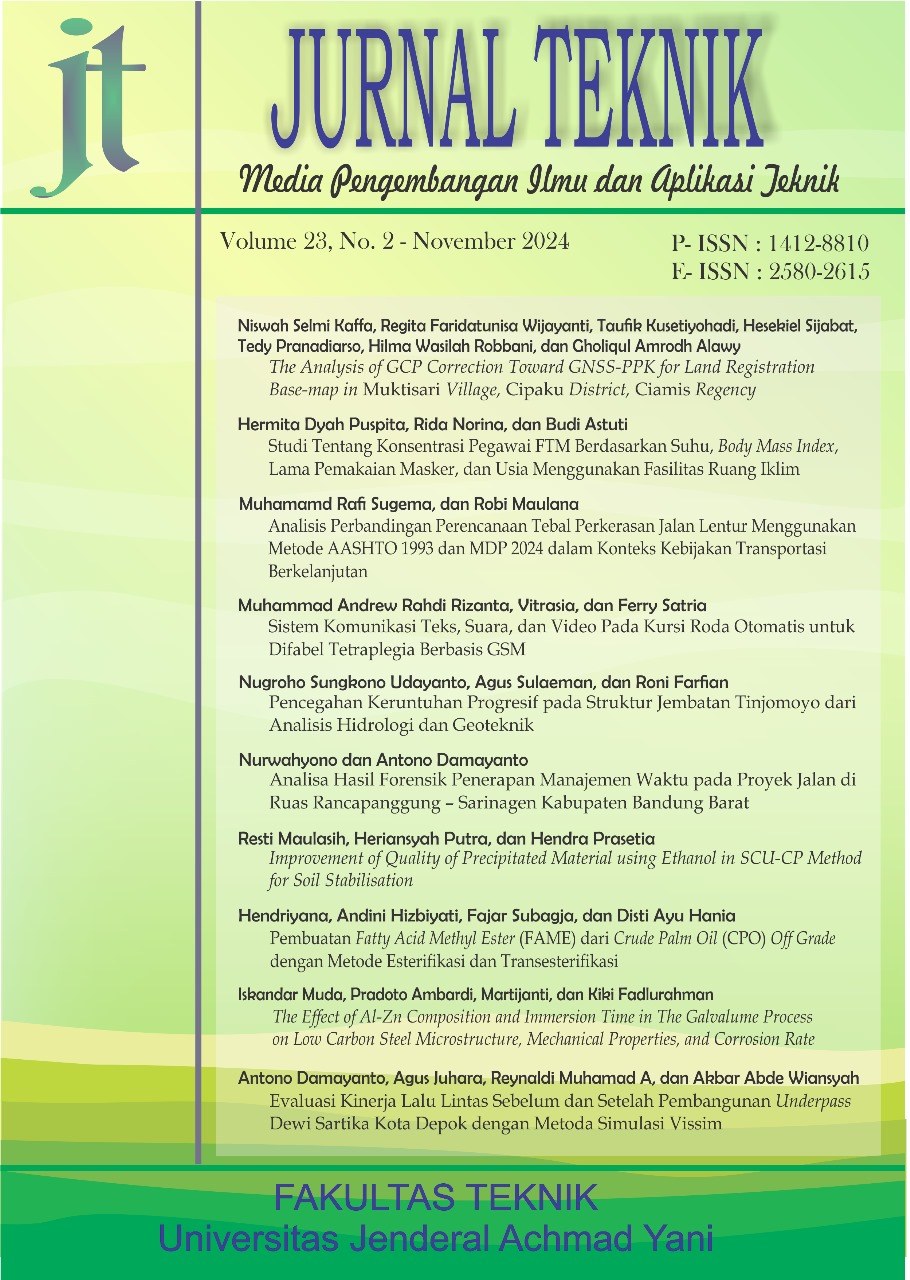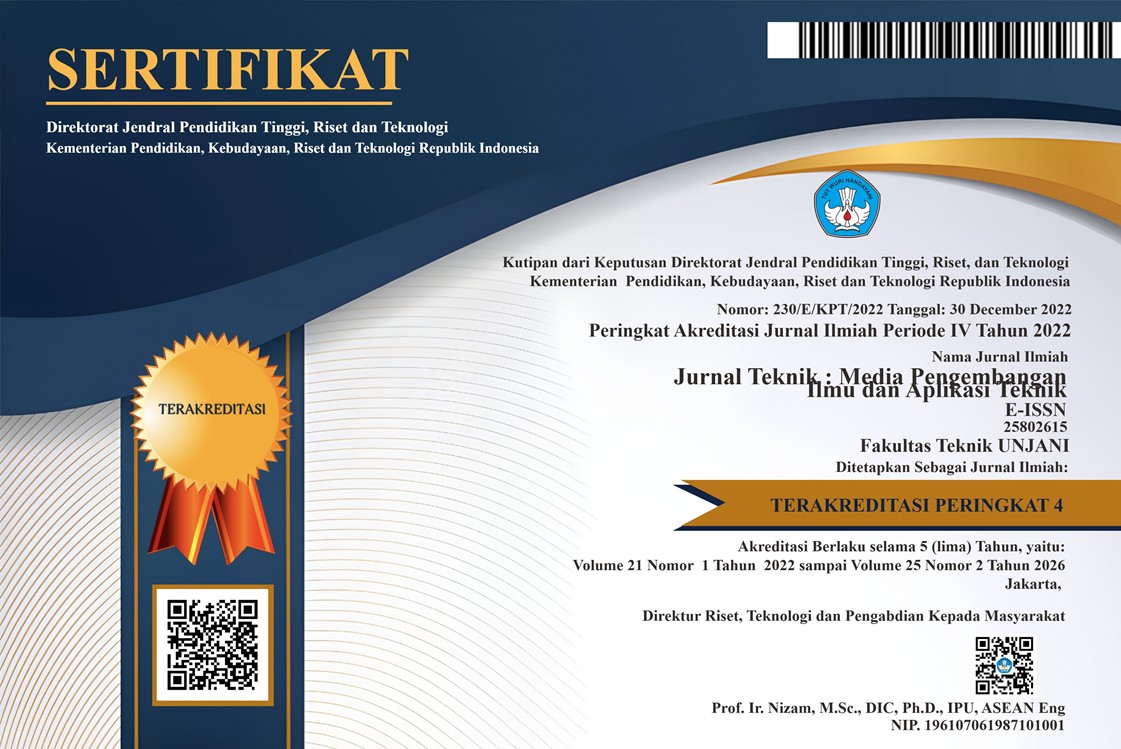Improvement of Quality of Precipitated Material using Ethanol in SCU-CP Method for Soil Stabilisation
DOI:
https://doi.org/10.55893/jt.vol23no2.670Keywords:
calcite, soybean, precipitation, ethanol, soil stabilisationAbstract
The use of high soybean concentrations in the calcite precipitation method promoted increasing organic content. Organic content can be reduced by using ethanol in the range of 20%-30%, so the effect of different soybean and ethanol concentrations must be evaluated to obtain the best quality CaCO3 precipitated material. The evaluation was carried out using hydrolysis rate, CaCO3 precipitation, and quantification of CaCO3 mass and mineral forms formed. The use of 20% ethanol at a soybean concentration of 60 g/L showed the best results with a hydrolysis rate of 1547 U/g, and this value is quite close to the value of the hydrolysis rate of 2 g/L Kishidan commercial urease. In addition, the mass of CaCO3 formed was 2,97 g, with more calcite than vaterite and aragonite. The insoluble organic mass in the soybean solution with ethanol is less than the variation without ethanol. It is related to using supernatants, which reduce the amount of organic content. The decrease in organic content affects the reduction in CaCO3 precipitate. The shape of the precipitate formed in calcite crystals (rhombohedral) is the best form to bind the soil to increase soil strength.
References
Afifah, F., & Cahyaningrum, S. E. (2020). Sintesis dan karakterisasi hidroksiapatit dari tulang sapi (Bos Taurus) menggunakan teknik kalsinasi synthesis and characterization of hydroxyapatite from cow bones (Bos Taurus) using calcination techniques. UNESA Journal of Chemistry, 9(3), 189–196.
Baiq, H. S., Yasuhara, H., Kinoshita, N., Putra, H., & Johan, E. (2020). Examination of calcite precipitation using plantderived urease enzyme for soil improvement. GEOMATE Journal, 19(72), 231–237.
Beck, R., & Andreassen, J.-P. (2010). The onset of spherulitic growth in crystallization of calcium carbonate. Journal of Crystal Growth, 312(15), 2226–2238.
Cuccurullo, A., Gallipoli, D., Bruno, A. W., Augarde, C., Hughes, P., & La Borderie, C. (2022). Earth stabilisation via carbonate precipitation by plant-derived urease for building applications. Geomechanics for Energy and the Environment, 30, 100230.
Fondjo, A. A., Theron, E., & Ray, R. P. (2021). Stabilization of expansive soils using mechanical and chemical methods: a comprehensive review. Civ Eng Archit, 9(5), 1295–1308.
Gao, Y., He, J., Tang, X., & Chu, J. (2019). Calcium carbonate precipitation catalyzed by soybean urease as an improvement method for fine-grained soil. Soils and Foundations, 59(5), 1631–1637.
Kristianingrum, S. (2012). Kajian berbagai proses destruksi sampel dan efeknya. Prosiding Seminar Nasional Penelitian, Pendidikan dan Penerapan MIPA, Fakultas MIPA, Universitas Negeri Yogyakarta, 2.
Lai, H.-J., Cui, M.-J., Wu, S.-F., Yang, Y., & Chu, J. (2023). Extraction of crude soybean urease using ethanol and its effect on soil cementation. Soils and Foundations, 63(3), 101300.
Lee, S., & Kim, J. (2020). An experimental study on enzymatic-induced carbonate precipitation using yellow soybeans for soil stabilization. KSCE Journal of Civil Engineering, 24(7), 2026–2037.
Loebis, A. R., & Putra, H. (2022). Efektivitas metode calcite precipitation dengan biocatalyst bubuk kedelai sebagai metode biogrouting untuk mencegah likuifaksi tanah pasir. TERAS JURNAL: Jurnal Teknik Sipil, 12(1), 23–34.
Mulyaningsih, S. (2018). Kristalografi & Mineralogi. Akpind Press.
Nemati, M., & Voordouw, G. (2003). Modification of porous media permeability, using calcium carbonate produced enzymatically in situ. Enzyme and microbial technology, 33(5), 635–642.
Neupane, D., Yasuhara, H., Kinoshita, N., & Ando, Y. (2015). Distribution of mineralized carbonate and its quantification method in enzyme mediated calcite precipitation technique. Soils and Foundations, 55(2), 447–457.
Peng, Y., Kersten, N., Kyriakopoulou, K., & van der Goot, A. J. (2020). Functional properties of mildly fractionated soy protein as influenced by the processing pH. Journal of Food Engineering, 275, 109875.
Pratama, G. B. S., Yasuhara, H., Kinoshita, N., & Putra, H. (2021). Application of soybean powder as urease enzyme replacement on EICP method for soil improvement technique. IOP Conference Series: Earth and Environmental Science, 622(1), 012035. https://doi.org/10.1088/1755-1315/622/1/012035
Putra, H., Erizal, Sutoyo, Simatupang, M., & Yanto, D. H. Y. (2021). Improvement of organic soil shear strength through calcite precipitation method using soybeans as bio-catalyst. Crystals, 11(9), 1044.
Putra, H., Yasuhara, H., Erizal, Sutoyo, & Fauzan, M. (2020). Review of enzyme-induced calcite precipitation as a ground-improvement technique. Infrastructures, 5(8), 66.
Putra, H., Yasuhara, H., Kinoshita, N., & Hirata, A. (2017). Optimization of enzyme-mediated calcite precipitation as a soil-improvement technique: The effect of aragonite and gypsum on the mechanical properties of treated sand. Crystals, 7(2), 59.
Robinson, P. K. (2015). Enzymes: principles and biotechnological applications. Essays in biochemistry, 59, 1.
Sand, K. K., Rodriguez-Blanco, J. D., Makovicky, E., Benning, L. G., & Stipp, S. L. S. (2012). Crystallization of CaCO3 in water–alcohol mixtures: spherulitic growth, polymorph stabilization, and morphology change. Crystal Growth & Design, 12(2), 842–853.
Shen, Y., Xie, A., Chen, Z., Xu, W., Yao, H., Li, S., Huang, L., Wu, Z., & Kong, X. (2007). Controlled synthesis of calcium carbonate nanocrystals with multi-morphologies in different bicontinuous microemulsions. Materials Science and Engineering: A, 443(1–2), 95–100.
Wardoyo, S., Destiasari, F., Wayhudin, W., Hasibuan, G., & Sollu, W. P. (2019). Atlas Sebaran Tanah Lunak Indonesia. Kementerian Energi dan Sumber Daya Mineral.
Whiffin, V. S. (2004). Microbial CaCO3 precipitation for the production of biocement. Murdoch University.
Wibawa, A., & Hisyam, E. S. (2015). Pengaruh penambahan limbah gypsum terhadap nilai kuat geser tanah lempung. FROPIL (Forum Profesional Teknik Sipil), 3(2), 65–71.
Additional Files
Published
Issue
Section
License
Copyright (c) 2025 Resti Maulasih, Heriansyah Putra, Hendra Prasetia Hendra Prasetia

This work is licensed under a Creative Commons Attribution-NonCommercial-ShareAlike 4.0 International License.
Penulis yang menyerahkan artikel di Jurnal Teknik: Media Pengembangan dan Aplikasi Teknik untuk keperluan publikasi telah mengetahui bahwa Jurnal Teknik: Media Pengembangan dan Aplikasi Teknik memberikan akses terbuka terhadap konten untuk mendukung pertukaran informasi mengenai ilmu pengetahuan, sesuai dengan penerbitan daring yang berbasis Open Access Journal dan mengikuti Creative Commons Attribution 4.0 International License. Sehingga penulis setuju dengan ketentuan-ketentuan berikut:
1. Penulis memegang hak cipta dan memberikan hak publikasi pertama kepada pihak jurnal dengan pekerjaan secara bersamaan
di bawah Creative Commons Attribution 4.0 International License yang memungkinkan orang lain untuk berbagi pekerjaan
dengan pengakuan kepengarangan karya dan publikasi pertama artikel tersebut di Jurnal Teknik: Media Pengembangan dan
Aplikasi Teknik.
2. Penulis dapat melakukan perjanjian tambahan untuk hak distribusi non-eksklusif artikel yang telah diterbitkan di jurnal ini
(misalnya, posting ke sebuah repositori institusi atau menerbitkannya dalam sebuah buku), dengan mengakui bahwa
publikasi pertama dilakukan di Jurnal Teknik: Media Pengembangan dan Aplikasi Teknik.
3. Penulis diizinkan dan didorong untuk menyebarkan karya mereka secara daring (misalnya, dalam repositori institusi atau
laman web penulis) setelah artikel terbit (proses penerbitan artikel selesai). Hal ini terkait dengan imbas dari pertukaran
informasi yang produktif (Lihat Pengaruh Open Access).












